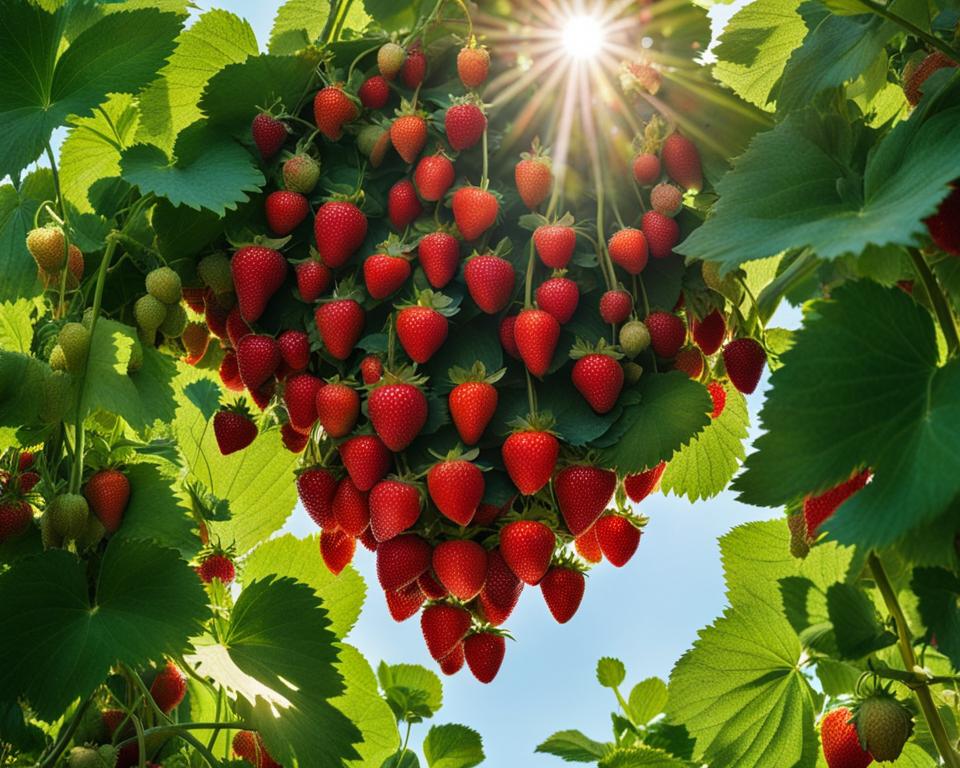Welcome to my article on vertical gardening systems for strawberries! If you’re looking to maximize your strawberry harvest potential, you’ve come to the right place. Through the use of vertical gardening, you can grow delicious strawberries in limited spaces, making it ideal for small balconies or large backyards.
Vertical gardening systems for strawberries are designed to save space and help you make the most use of your garden’s vertical area. With these systems, you can grow your strawberries on walls, towers, or trellises, creating a unique and visually appealing garden.
In this article, I will be discussing the benefits of using vertical gardening systems for strawberries, how to choose the best system for your needs, and tips for setting up and caring for your vertical strawberry garden.
So, let’s dive in and discover the world of vertical gardening systems for strawberries!
Key Takeaways:
- Vertical gardening systems for strawberries allow you to grow delicious fruits in limited spaces.
- These systems make the most use of your garden’s vertical area, with plants grown on walls, towers, or trellises.
- Using a vertical gardening system offers benefits such as better air circulation and sunlight exposure for healthier plants and increased fruit production.
- When selecting a system, consider factors such as space availability, budget, and personal preferences.
- Proper care and maintenance are essential for the success of your vertical strawberry garden.
Why Choose Vertical Gardening for Strawberries?
If you’re looking for an innovative way to grow strawberries and maximize your space, vertical gardening systems for strawberries are an excellent choice. These systems allow you to grow your strawberries vertically, saving valuable space in your garden or balcony. Depending on the size of your garden or balcony, you can choose from a variety of strawberry vertical gardening systems, including:
- Strawberry towers
- Wall planters
- Vertical strawberry planters
Vertical gardening is also an aesthetically pleasing way to grow your strawberries. You can create unique designs and arrangements that are visually appealing and add a touch of greenery to your space.
Why Vertical Gardening Systems for Strawberries?
Vertical gardening systems are ideal for small gardens or balconies because they allow you to use your vertical space, maximizing your available growing area. Strawberry plants can be grown in a variety of vertical gardening systems, including:
| System | Pros | Cons |
|---|---|---|
| Strawberry Tower |
|
|
| Wall Planter |
|
|
| Vertical Strawberry Planter |
|
|
By growing your strawberries vertically, you’ll also benefit from better air circulation and sunlight exposure, which results in healthier plants and increased fruit production. Additionally, the elevated position of the plants makes it easier to manage pests and diseases, as they are less prone to ground-level issues.
Tip: Regardless of the system you choose, make sure to select high-quality soil and strawberry plants suitable for your climate.
Overall, vertical gardening systems for strawberries offer a convenient, space-saving, and customizable solution to growing delicious strawberries at home.
Benefits of Vertical Gardening Systems for Strawberries
In this section, we will explore the advantages of vertical gardening systems for growing strawberries. Vertical gardening is an innovative and space-efficient way to grow strawberries that has gained popularity in recent years. With these systems, you can grow strawberries in a variety of vertical arrangements, such as strawberry towers, wall planters, and vertical strawberry planters. Here are some benefits:
Better Air Circulation and Sunlight Exposure
Vertical gardening systems for strawberries allow for better air circulation around the plants, which helps to prevent pest infestations and diseases. Additionally, the elevated position of the plants allows them to receive more sunlight, resulting in more photosynthesis and increased fruit production.
Easier Pest and Disease Management
With vertical gardening systems, the plants are elevated and less prone to ground-level pests and diseases. Moreover, the plants are spaced farther apart, reducing the risk of diseases spreading between them. Vertical gardening systems also make it easier to inspect and treat plants for pest and disease issues.
Convenient and Customizable
Vertical gardening systems for strawberries are space-saving and can be customized to fit any garden or balcony. They are easy to install and maintain, and you can add or remove plants as needed. Additionally, because the plants are vertical, harvesting is convenient and easy, and you won’t have to bend over to pick your strawberries.
Improved Soil Quality
Vertical gardening systems for strawberries require less soil than traditional gardening methods. This means you can use high-quality soil and add amendments to improve its quality without breaking the bank. Additionally, you can easily monitor and adjust soil pH and nutrient levels to ensure optimal plant growth.
Increased Yield
Vertical gardening systems for strawberries can produce a higher yield per square foot than traditional gardening methods. This is because the plants’ vertical arrangement allows for more efficient use of space and increased planting density. Additionally, the plants are healthier and more productive, resulting in more delicious strawberries for you to enjoy!
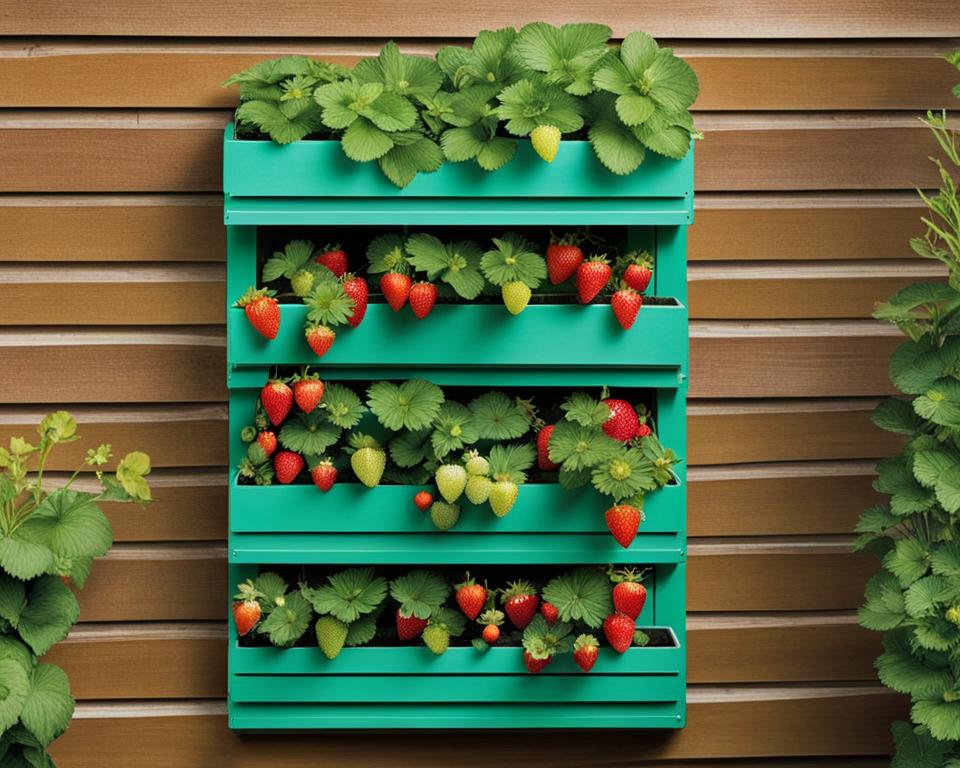
Choosing the Best Vertical Gardening System for Strawberries
When it comes to selecting the best vertical gardening system for strawberries, there are several factors to consider. You want to choose a system that fits your space and budget while also providing optimal growing conditions for your plants. Here are some tips to help you make the right choice:
Space Availability
The first consideration is how much space you have for your vertical garden. If you have a small balcony or limited outdoor space, you may want to choose a compact system like a strawberry tower or a wall planter. These systems take up minimal space while still providing ample room for your plants to grow.
On the other hand, if you have a large backyard or garden, you may have more options for vertical gardening systems. You could consider a trellis system or a customized vertical garden design that utilizes several planters or containers.
Budget
Another important factor to consider is your budget. Vertical gardening systems come in a range of prices, from affordable DIY options to more expensive pre-fabricated systems. You’ll want to choose a system that fits within your budget while still providing the features and benefits you need.
Keep in mind that more expensive systems may offer better durability, quality, and customization options, while DIY options may require more effort and expertise to assemble and maintain.
Personal Preferences
Finally, you’ll want to choose a system that aligns with your personal preferences and gardening style. Consider factors such as design, aesthetics, ease of use, and level of customization.
For example, if you prefer a sleek and modern look, you may opt for a vertical strawberry planter with a minimalist design. If you like a more organic and rustic style, you might prefer a trellis system with natural materials like wood or bamboo.
Comparison Table
| System Type | Space Required | Budget | Customization | Recommended For |
|---|---|---|---|---|
| Strawberry Tower | Minimal | Affordable | Limited | Small Balconies and Patios |
| Wall Planter | Minimal | Affordable | Customizable | Small Spaces and Walls |
| Vertical Strawberry Planter | Minimal | Mid-Range | Customizable | Small to Medium Spaces |
| Trellis System | Medium to Large | Mid-Range to Expensive | Highly Customizable | Large Gardens and Yards |
Note: Prices and space requirements may vary depending on the brand and model.
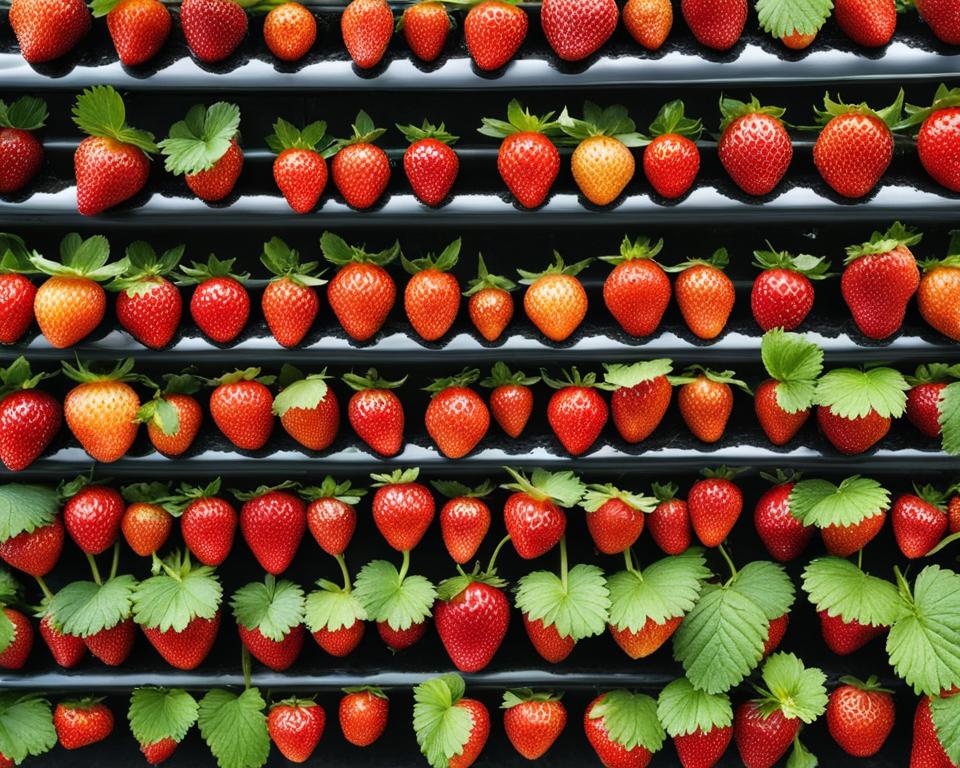
Setting Up Your Strawberry Vertical Garden
Now that you have chosen the perfect vertical gardening system for your strawberries, it’s time to set up your garden. Here are the steps you should follow to ensure a successful garden:
- Select the right soil: Use high-quality soil with good drainage and aeration. Strawberries prefer slightly acidic soil with a pH between 5.5 and 6.5.
- Choose suitable strawberry plants: There are various strawberry varieties available, so choose the ones that work best in your climate. Look for certified disease-free plants from a reputable nursery or online store.
- Assemble your vertical gardening system: Follow the instructions provided with your chosen system to assemble and install it correctly. Make sure the system is sturdy and secure before planting your strawberries.
- Position your garden: Place your vertical gardening system in a sunny location that receives at least 6-8 hours of sunlight per day. Also, make sure it’s easily accessible for watering and harvesting.
- Plant your strawberries: Dig small holes in the soil or insert plants into the pockets of your chosen system. Make sure to space them appropriately and cover the roots with soil.
- Water your plants: Water your strawberries regularly to ensure the soil stays moist. Avoid overwatering, as this can lead to root rot.
Now that your vertical strawberry garden is set up, it’s time to provide proper care and maintenance to ensure healthy and productive plants.
Caring for Your Vertical Strawberry Garden
Proper care and maintenance are essential for a successful vertical strawberry garden. Here are some tips to help you grow healthy and productive plants:
- Watering: Keep the soil moist but not waterlogged. Vertical gardening systems for strawberries may require more frequent watering due to their vertical structure and smaller soil capacity.
- Fertilizing: Use a balanced fertilizer to provide your plants with the necessary nutrients. Follow the instructions on the package for proper application. Avoid over-fertilizing, as this can lead to burned roots and reduced fruit production.
- Pruning: Regularly prune dead or damaged leaves to promote healthy new growth and prevent the spread of diseases.
- Pest Management: Monitor your plants for pests and diseases regularly. Use organic pest control methods, if possible, to avoid harmful chemicals that can harm your plants and the environment.
- Support: Vertical gardening systems for strawberries may require additional support as the plants grow taller and heavier. Use stakes or trellises to prevent them from falling over or breaking.
By following these tips, you can ensure the success of your strawberry growing systems and enjoy a bountiful harvest of delicious, homegrown strawberries. Remember to monitor your plants regularly and make adjustments as necessary to optimize their growth and productivity.
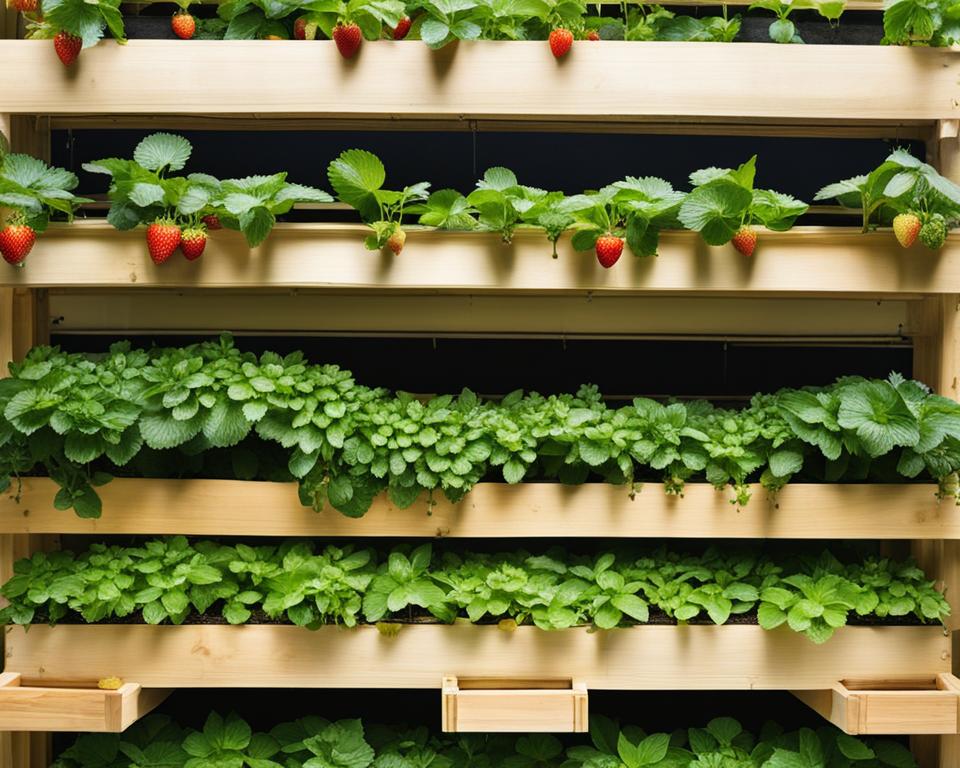
Harvesting and Enjoying Your Homegrown Strawberries
After weeks of patiently waiting, it’s finally time to harvest your homegrown strawberries! As you gently pluck the ripe, juicy fruits from your vertical garden, you can savor the rewarding experience of growing your own produce.
Here are some tips to help you make the most of your strawberry harvest:
- Harvest your strawberries in the morning when they are cool and fully ripe. This is when they will have the best flavor and texture.
- Use a pair of scissors or garden shears to snip the stem of the strawberry as close to the fruit as possible, taking care not to damage the plant.
- Don’t wash your strawberries until you are ready to eat them, as moisture can cause them to spoil faster. Instead, store them in a cool, dry place.
- If you have a large harvest, consider freezing some of your strawberries to enjoy later in the year. Simply remove the stems and freeze them in a single layer on a baking sheet. Once frozen, transfer them to a freezer bag or container.
Once you have harvested your strawberries, it’s time to enjoy the fruits of your labor. Whether you prefer them fresh, baked into pies or muffins, or blended into smoothies, the possibilities are endless.
“There are few things as satisfying as indulging in delicious, homegrown strawberries that were cultivated with your own two hands.”
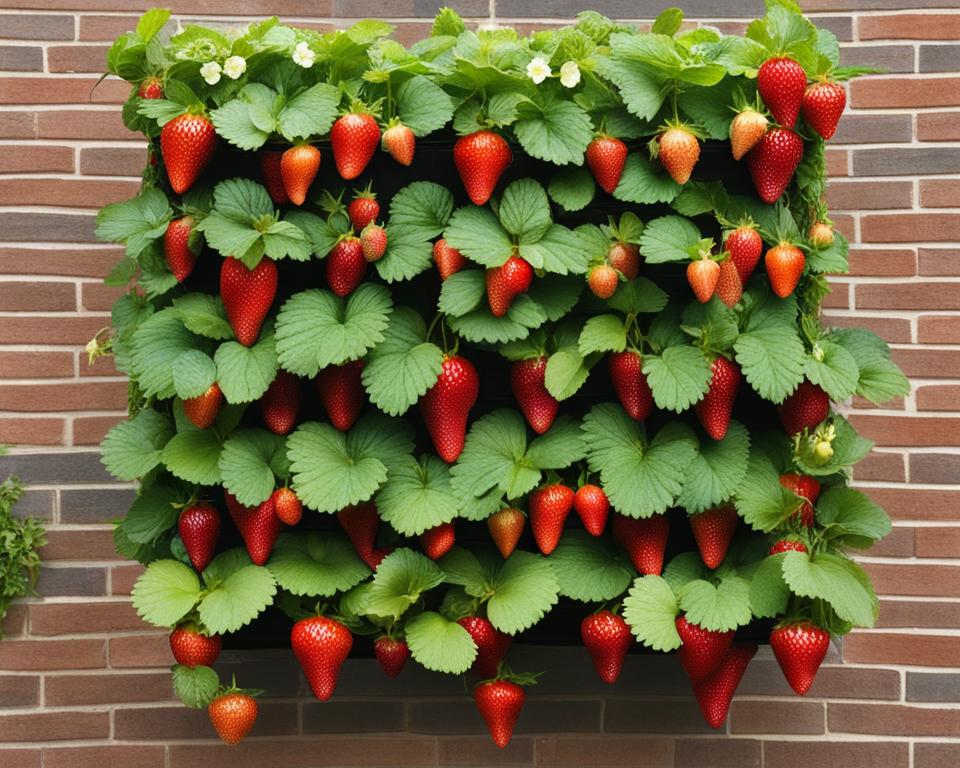
So go ahead, invite your friends and family over for a tasty treat, and share the joy of your homegrown strawberries. You’ve earned it!
Troubleshooting Common Issues in Vertical Strawberry Gardens
While vertical gardening systems for strawberries are generally easy to maintain, there are some common issues that may arise. Here are some tips to help you address and prevent them:
Problem: Nutrient Deficiencies
If your strawberry plants are exhibiting signs of nutrient deficiencies, such as yellowing leaves, stunted growth, or poor fruit production, it’s likely that they’re not receiving adequate nutrients. To remedy this, fertilize your plants with a balanced fertilizer formulated specifically for strawberries. Be careful not to over-fertilize, as this can lead to other issues.
Problem: Pests and Diseases
Pests and diseases can wreak havoc on your vertical strawberry garden if left unchecked. Common pests include aphids, slugs, and spider mites, while diseases such as powdery mildew and gray mold can also occur. To control pests, remove any affected leaves or plants and use natural or chemical treatments as necessary. To prevent diseases, ensure good air circulation and avoid over-watering.
Problem: Environmental Factors
The success of your vertical strawberry garden can be impacted by environmental factors such as temperature, humidity, and light. Make sure your plants are receiving adequate sunlight (at least 6 hours per day) and are protected from extreme temperatures and wind. Additionally, provide shade during hot summer days to prevent sunburn on the fruit.
By addressing these common issues promptly and taking proactive measures to prevent them, you can ensure the health and productivity of your vertical strawberry garden. Happy gardening!
Enhancing Your Vertical Strawberry Garden
If you want to take your vertical strawberry garden to the next level, consider adding some creative touches to enhance its aesthetic appeal. Here are some strawberry vertical garden ideas and vertical strawberry garden design tips:
- Add colorful flowers: Combining strawberries with colorful flowers can create a stunning visual display. Consider planting petunias, marigolds, or pansies alongside your strawberries to add a pop of color.
- Use unique planters: Don’t limit yourself to standard vertical garden planters. Get creative and use unique containers such as old gutters, wooden pallets, or even repurposed shoe organizers. The possibilities are endless!
- Include companion plants: Certain herbs and flowers can act as natural pest repellents and attract beneficial insects to your garden. Consider adding basil, lavender, or mint to your vertical strawberry garden.
- Experiment with different layouts: Whether you prefer a symmetrical or asymmetrical design, there are plenty of ways to arrange your vertical strawberry garden. Play around with different patterns and layouts to find one that suits your style.
By incorporating these strawberry vertical garden ideas and vertical strawberry garden design tips, you can create a unique and visually stunning garden that will provide you with delicious fruits for years to come.
Tips for Successful Vertical Gardening with Strawberries
Vertical gardening systems for strawberries are a great way to grow your own fresh and delicious fruit at home, but they require proper care and maintenance to be successful. Here are some useful tips to help you maximize your harvest potential:
- Choose the right strawberry variety for your growing environment and climate. Some varieties are better suited for vertical gardening than others.
- Provide adequate support for your plants, especially as they mature and become heavy with fruit. This will prevent them from falling over and potentially damaging the plant or fruit.
- Monitor and adjust your watering schedule according to the needs of your plants. Vertical gardening systems can dry out quickly, so it’s important to keep the soil consistently moist but not waterlogged.
- Fertilize your plants as needed with a balanced fertilizer to promote healthy growth and fruit production.
- Regularly check for pests and diseases and take appropriate measures to control them before they affect your entire crop.
- Prune any dead or damaged leaves to promote healthy growth and better fruit production.
- Clean your vertical gardening system regularly to prevent the buildup of debris and pests.
Additional Tips for Successful Vertical Gardening with Strawberries
Here are some more tips that can help you achieve even better results with your vertical gardening system for strawberries:
- Consider planting companion plants such as herbs or flowers that can attract beneficial insects and improve soil health.
- Rotate your crops every few years to prevent soil-borne diseases and promote better soil health.
- Harvest your strawberries regularly to promote continued fruit production and prevent overcrowding.
- Experiment with different vertical gardening systems and designs to find the one that works best for your needs and preferences.
By following these tips, you can enjoy a bountiful and delicious harvest of fresh strawberries grown right at home in your vertical gardening system.
Exploring Different Vertical Gardening Systems for Strawberries
Vertical gardening is a fantastic way to grow strawberries at home, and there are various systems available to use. In this section, I will explore some of the most popular vertical gardening systems for strawberries, including strawberry towers, wall planters, and vertical strawberry planters. Let’s take a closer look!
Strawberry Towers
Strawberry towers are perhaps the most popular vertical gardening system for strawberries. They are tall, vertical structures with staggered pockets or holes for planting strawberries. The pockets are typically made from materials such as PVC pipes, clay pots, or stacked containers. Strawberry towers are perfect for small spaces and can hold a large number of strawberry plants.
One popular strawberry tower design is the “pyramid” style, which consists of stacked containers or pots with the widest container at the bottom and the smallest at the top. The containers can be filled with soil and compost, and the strawberries are planted in the pockets or holes. A pyramid-style strawberry tower can hold anywhere from 20 to 100 strawberry plants, depending on its size.
Wall Planters
Wall planters are another great vertical gardening system for strawberries, especially if you have limited outdoor space. They can be hung on walls or fences and come in various sizes and designs. One popular wall planter design for strawberries is the “pocket” style, with several pockets or pouches attached to a single panel.
Wall planters are ideal for growing strawberries because they provide good drainage and allow for better air circulation. They are also easy to maintain and can be moved around if needed. To use a wall planter for strawberries, simply fill the pockets with soil and compost, and plant your strawberries in them.
Vertical Strawberry Planters
Vertical strawberry planters are designed to hold several strawberry plants in a vertical arrangement. They are usually made from materials such as fabric or felt and come in various sizes and shapes. One popular design is the “hanging bag” style, which can be hung on walls, fences, or balconies.
Vertical strawberry planters are great for small spaces and can hold up to 25 strawberry plants, depending on their size. They are also easy to maintain and can be moved around if needed. To use a vertical strawberry planter, simply fill it with soil and compost, and plant your strawberries in the pockets or pouches.
Comparing the Different Vertical Gardening Systems
| System | Advantages | Disadvantages |
|---|---|---|
| Strawberry Towers | Hold many plants, easy to water and fertilize, visually appealing | May be difficult to assemble, may take up more space than other systems |
| Wall Planters | Good for small spaces, easy to maintain and move, visually appealing | May not hold as many plants, may require more frequent watering |
| Vertical Strawberry Planters | Good for small spaces, easy to maintain and move, can hold up to 25 plants | May not hold as many plants, may require more frequent watering |
As you can see, each vertical gardening system for strawberries has its own unique advantages and disadvantages. Consider factors such as space availability, budget, and personal preferences when choosing a system that works best for you.
Now that you have a better understanding of the different vertical gardening systems for strawberries, you can choose the one that suits your needs and preferences. Happy gardening!
Conclusion
As a vertical gardening enthusiast and a lover of strawberries, I can confidently say that vertical gardening systems for strawberries are a game-changer. Not only do they save space, but they also offer numerous benefits such as improved air circulation, sunlight exposure, and pest management.
Taking Care of Your Vertical Strawberry Garden
Remember that caring for your vertical strawberry garden is essential for its success. Regularly watering your plants, fertilizing as needed, pruning dead or damaged leaves, and monitoring for pests and diseases are crucial steps in ensuring healthy growth and abundant fruit production.
Exploring Different Vertical Gardening Systems
With a variety of vertical gardening systems available, you can choose one that best suits your needs and preferences. Whether you opt for a strawberry tower, wall planter, or a vertical strawberry planter, each system has unique features and benefits to offer.
Tips for Successful Vertical Gardening with Strawberries
To achieve optimal results with your vertical gardening system for strawberries, keep in mind to select the right strawberry varieties, provide adequate support, monitor and adjust watering needs, and check for pests and diseases regularly. These simple tips can help you grow healthy and delicious strawberries with ease.
Vertical gardening systems for strawberries offer a fantastic opportunity to grow your own delicious fruits, no matter the size of your space. It’s a rewarding and fulfilling experience that allows you to taste the fresh, sweet flavors of homegrown strawberries. So, why not give it a try? Start your vertical strawberry garden today and enjoy the fruits of your labor!
FAQ
What is vertical gardening?
Vertical gardening is an innovative way to grow plants that utilizes vertical space, allowing you to make the most of limited areas by growing plants vertically on walls, trellises, or towers.
Why should I choose vertical gardening for strawberries?
Vertical gardening for strawberries is ideal for small spaces and offers a unique and visually appealing garden. It allows you to maximize your harvest potential while saving space.
What are the benefits of vertical gardening systems for strawberries?
Vertical gardening systems offer better air circulation, sunlight exposure, and easier pest and disease management. They are convenient, space-saving, and can be customized to fit any garden or balcony.
How do I choose the best vertical gardening system for strawberries?
Consider factors such as space availability, budget, and personal preferences. Options include strawberry towers, wall planters, and vertical strawberry planters. Choose one that suits your needs and garden aesthetics.
How do I set up a strawberry vertical garden?
Start by selecting high-quality soil and strawberry plants suitable for your climate. Follow the instructions provided with your chosen system to assemble and install it properly. Position your garden for adequate sunlight and access for watering and harvesting.
How do I care for my vertical strawberry garden?
Regularly water the plants to keep the soil moist but not waterlogged. Fertilize as needed and prune any dead or damaged leaves. Monitor for pests and diseases and provide support to prevent plants from falling over.
How do I harvest and enjoy my homegrown strawberries?
Gently pluck ripe strawberries from the plants and enjoy their sweet and juicy flavors. Use them in recipes or enjoy them fresh. Share your harvest with family and friends for an extra treat.
What are some common issues in vertical strawberry gardens?
Common issues can include nutrient deficiencies, pests, diseases, or environmental factors. Stay vigilant and address any problems promptly to ensure the health and productivity of your strawberry plants.
How can I enhance my vertical strawberry garden?
Consider adding companion plants such as herbs or flowers for beneficial insects and visual appeal. Experiment with different arrangements and designs to create a stunning and productive vertical garden.
What are some tips for successful vertical gardening with strawberries?
Select the right strawberry varieties, provide adequate support, monitor and adjust watering needs, and regularly check for pests and diseases to ensure optimal results.
What are some different vertical gardening systems for strawberries?
There are various systems available, including strawberry towers, wall planters, and vertical strawberry planters. Explore the features and benefits of each system to choose the best one for your needs.

